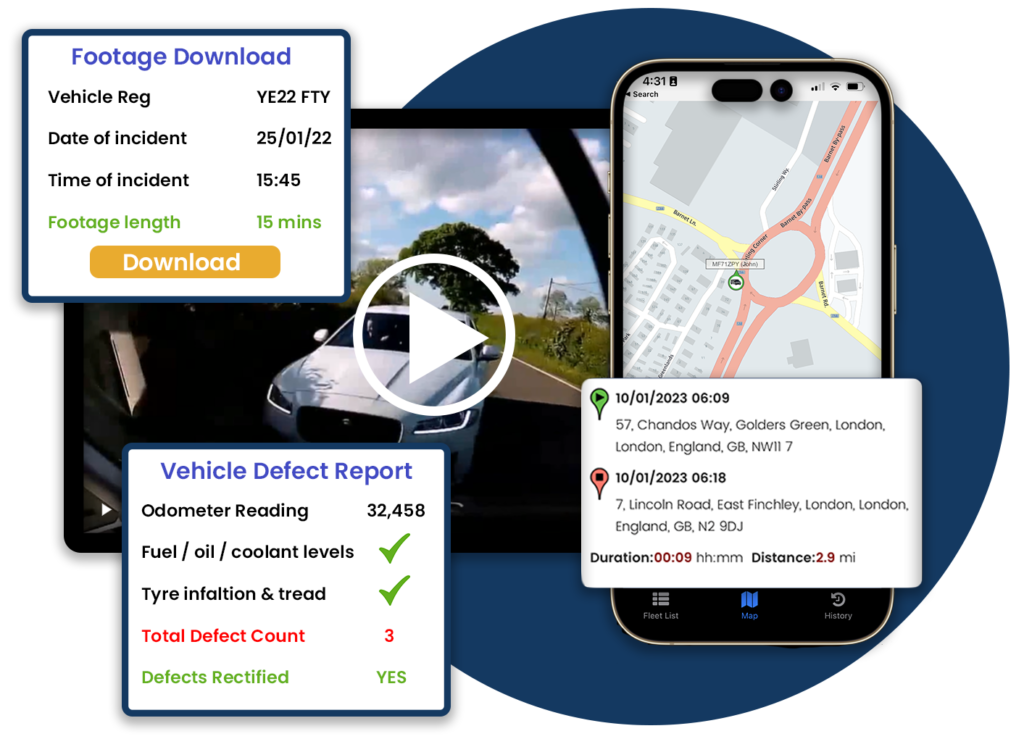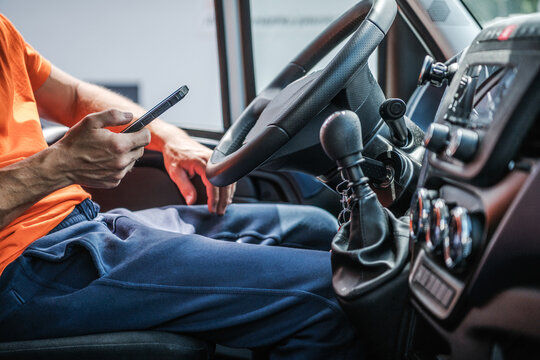Fleet safety requirements in the UK and Greater London are becoming stricter. The Progressive Safe System (PSS) will come into effect in October 2024 for lorries over 12 tonnes, making it challenging for ‘concern vehicles’ to operate. Furthermore, with increased expectations for vans and cabs, fleet managers must ensure their vehicle tracking systems and video monitoring systems meet stringent minimum requirements or face fines.
Smart Behaviour Recognition Technology Taking the Wheel
A significant aspect of fleet monitoring is recording driver/operator behaviour. Until recently, dash cams collected footage that would be used for reactive purposes, such as after an incident.
However, AI-powered inward-facing dash cams now incorporate innovative technology that identifies risky driving behaviour as it happens. This allows for proactive intervention and accident prevention in real time, too. Examples of these preventative measures include in-cab and external alerts.
In short, AI dash cams help to create a holistic view of a fleet by aiding the prevention of accidents and the reduction of costs through behaviour monitoring.
Let’s explore the features and capabilities of AI dash cams to see why they are becoming an integral aspect and requirement for driver safety and fleet management in the UK.
But First: Understanding Fleet Safety Challenges
Driving a truck, van, or car presents challenges, but those challenges are amplified when you own a fleet of vehicles. The drivers of fleet vehicles represent the company that they work for, and the company is accountable for their actions and reactions while on duty, and each company has a corporate responsibility of duty of care.
Fleet managers must employ, train, and monitor operators capable of operating their respective fleet vehicles in routine and high-risk situations. Risky road situations can be categorised as environmental (external, such as weather) and behavioural (i.e., the driver’s behaviour).
External Risks to Fleets
– Adverse weather conditions.
– Road congestion.
– Mechanical failures.
Behavioural Risks Affecting Fleet Drivers
– Erratic driving behaviour such as speeding and aggressive driving.
– Reactions to external risks like a lack of advanced driver or operator training.
– Distracted driving caused by using a mobile phone or falling asleep behind the wheel.
Of the behavioural risks, distracted driving stands out as a pervasive risk for fleet managers. Whether through mobile use, smoking, or fatigue, any distraction diverts attention away from the road, notwithstanding that some of these behaviours are illegal and also in breach of company policy.
With eyes off the road and diverted attention, reaction times become impaired, dramatically increasing the likelihood of road traffic accidents.
How Real-Time Driver Behaviour Monitoring Helps Prevent Collisions
Real-time behaviour monitoring is indispensable—and now necessary—components of fleet management. The camera can promptly intervene or send a real-time alert to the driver and fleet manager if the AI detects distracted driving, such as smoking, using a mobile phone, or looking to the side for extended periods. The sooner a risk is detected, the sooner corrective actions can be taken, and thereby immediately reducing the risk of accidents occurring and providing an invaluable improvement to the driver’s welfare and road safety for all road users.
So, fleet managers can now proactively address potential safety hazards and provide feedback to the driver while the driver receives on-the-job training from the alerts, too. Managers can also use the data to formulate targeted driver training programmes to promote safe driving habits under specific conditions. However, this need is reduced due to the on-call coaching the alerts provide.
The key objective is to reduce road accidents, improve the driver experience, and promote safer driving habits among fleet drivers, and Crystal Ball’s inward-facing AI dash cameras offer an ideal solution.
The Role of Dash Cams in Fleet Safety
Crystal Ball’s SmartCam is a new advanced addition to our range of vehicle tracking and fleet management products. It incorporates artificial intelligence algorithms with traditional dash cam functionality to provide video evidence to fleet managers. Here are some of its driver safety and behaviour detection functions:
– Using mobile phones.
– Falling asleep at the wheel.
– The driver becomes distracted and stops looking at the road ahead.
– Smoking while driving.
Upon detecting these behaviours, the AI dash cam will immediately alert the driver to remind them to focus, helping to ensure their safety and the safety of others.
Additional AI Dash Cam Functions
The SmartCam also includes these functions that help with optimising the safety of fleets on the road:
Driver Behaviour System: This system scores individual driver behaviour according to KPIs. The scores are then available as analytics, league tables, and reports for easy analysis and processing.
Driver Identification: Helps to keep track of who is driving which vehicle at all times, providing another layer of safety and the opportunity to identify behavioural trends.
Driver Duty Tracking: Each time a driver is identified, it can act as a logbook for working hours. That way, their driving hours can be monitored to ensure they don’t work overtime or extended shifts.
Real-time HD video recording: Real-time footage is immediately uploaded to the cloud for remote access. High-definition video footage enables thorough investigation and incident resolution, helping reduce false claims and associated costs.
GPS Tracking: The SmartCam incorporates GPS vehicle tracking, which also helps to track vehicles, and set geofencing alerts, keeping them out of unsafe or no-access zones.
Vehicle Defect Reporting: Drivers can use the camera to report defects as they arise, meaning the vehicle can be better maintained and road safe.
More on Proactive Smart Behaviour Recognition Technology
Until recently, dash cam footage and reports helped investigate what happened during specific incidents and deal with the situation reactively. However, it’s preferable to act proactively to reduce accidents as much as possible. That’s where smart behaviour recognition technology steps in:
– It can set off an in-cab warning or notification to alert the driver of their risky driving behaviour.
– It can send a real-time notification and video to the fleet manager for remote monitoring and intervention.
Stopping Bad Driving Behaviour In Its Tracks
Greater London and parts of the UK are clamping down on fleet vehicles to improve road safety in these areas. As such, facial recognition technology is becoming necessary for fleets operating in Greater London. Driver-facing AI dash cams use facial recognition technology to monitor drivers’ behaviour in real-time and proactively intervene where necessary.
This innovative technology transforms fleets’ safety, offering a more holistic approach to risk prevention by promoting safe driving. Additionally, fewer incidents, near-misses, and accidents mean lower costs and insurance claims, freeing fleet maintenance and improvement funds.
As an approved partner of Driving for Better Business and a major advocate for road safety, Crystal Ball’s dash cam technologies and services encourage good behaviour behind the wheel. Talk to our team to learn more about how we can help businesses of all scopes and sizes.


